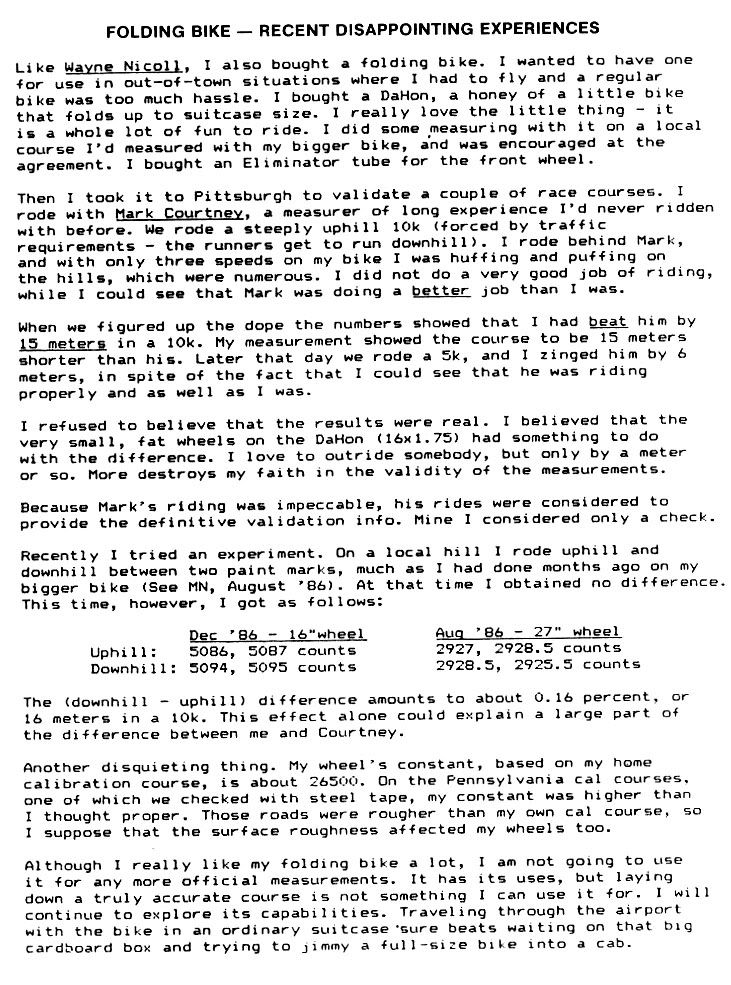1. Electrically assisted bicycle - choose one with a 250 watt motor driving the crank or rear wheel, not the front wheel which would upset the measurement readings. If instead of a hand controlled throttle, it has a torque sensor to measure the pedal effort and adjust the motor power in proportion, you will find it rides exactly like a pedal bicycle except hills, headwinds etc will become easy to ride without effort or wobble. It also helps with endurance - a marathon becomes as easy as it was years ago! Link
2. Laser distance meter - to layout calibration courses without having to scrabble around on the ground every 50 metres at the end of a steel tape. I am using the Bosch GLM250VF which has a maximum range of 250 metres. It is mounted on an equatorial telescope mount. Link
Longer calibration courses up to 500m can be measured by placing plastic retro-reflectors at both of the end nails and using the laser measure from near the centre point to the endpoints. See Mark Neal's report.
My latest use of my GLM250VF on last Saturday was to confirm a 249.775m calibration course which I had set out on a pavement in Llandudno last April. A ladies world best 24 hour distance of 247.076 km had been set, and I was engaged on a validation measurement of the distance. The average cal course length from 4 laser readings gave 249.776m, which was a rather fortuitously close agreement since Class II steel tapes have a maximum error of 0.02% ie 50mm, and the Bosch Laser with a good signal from a retro reflector has a stated maximum error of 0.005% i.e. 12.5mm.
3. For a person who finds it tiring to be repeatedly, bending/kneeling to mark the road, we need gadgets to insert PK nails from a standing position, and also to paint/chalk the road while in a standing position. I have yet to look for aids to achieve this. It is important - last week, while chalking the 6.33 metre turning radius at the ends of the Llandudno 1.0276 km course, I had a bystander come over and ask if I was OK; he had been concerned to see me repeatedly getting to my hands and knees and then struggling up again. This has happened to me at least twice before. I think it is giving me a message that at my age and with my worsening agility, I should no longer be going on my knees in public places.
4. Handle bar readout of counts - my eyesight is still good enough to read the counter on the front axle, but I have made reading mistakes - particularly at night. In the past there was the cable extension available for the JO counter produced by Laurent Lacroix, however he stopped producing these in 2007 when he had difficulty with the supply of parts. Link
In 2008 Tom Riegel worked on modifying the JR counter for handlebar display - but the conclusion in 2009 was that production manufacture was not viable. Link
More recently there was some interesting work by Bob Wemer, Mike Coyne, and Ken Hardwick on use of cameras to display the reading of an axle mounted Jones counter. Link
Neville and others have advocated the use of electronic counters of the type triggered by one or more magnets attached to the front wheel spokes. As described by Neville in numerous posts on this forum, these counters can be successfully used to give a handlebar display, and also simplify some aspects of the measurement procedures. However, in December 2009 the RRTC, concerned about the reliability of the methods advocated by Neville in the hands of novice measurers, came up with a policy that effectively banned the reliance on electronic counters in many situations. Link
quote:The Electronic Counter is approved for measuring courses for certification only by those that have used this device previously, with the following exceptions:
a It is not be used for measurement of AIMS/IAAF courses.
b.It is not be used for measurement for any big-city marathons, Olympic Trials, Olympic Marathons or National Championship Races.
c.It may not be used for Validation measurements.
I conclude there is still scope for an improved gadget to give handle bar readout. I suspect that this would be appreciated not just by elderly measurers with deteriorating eyesight, but also by younger measurers, and while we are about it those direct km and metre or mile displays advocated by Neville would also help.
I have concentrated here on devices which can help elderly measurers, extend their measuring career. Some will also be of interest to younger measurers. Are there any ideas out there of how to devise gadgets for items 3 or 4 above, to mark the road without kneeling, or for a handlebar readout? Does anyone have other ideas for useful gadgets?




